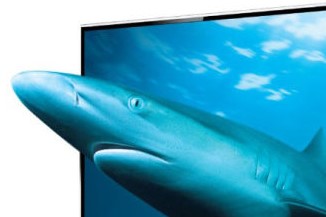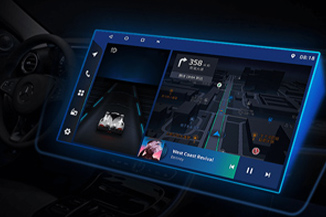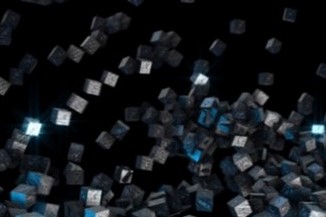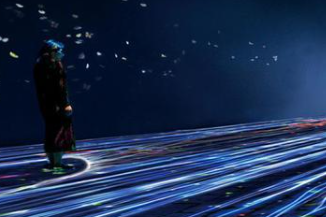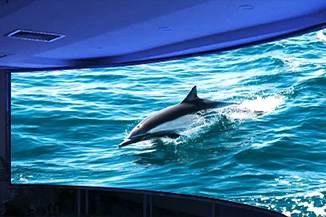Publisher: Supplier of LED Display Time: 2022-08-22 12:01 Views: 1957
The general trend of global color TV in 2022 is "big screen": with the help of a new round of price cuts and the shrinking global color TV market, the shipment of 75-inch and above LCD panels will increase by more than 20% in the first half of the year. Large screens can directly provide better immersion and shock, which is why large screen products are increasingly popular.
In fact, during the development of display devices such as color TVs, efforts around greater immersion have not stopped. The 3D TV boom that started more than ten years ago (2008), the curved surface boom that started ten years ago (2012), and the ever-increasing high-definition, full-HD, and ultra-high-definition boom are all to provide a better sense of immersion.
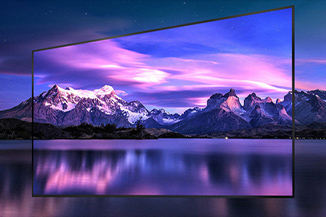
At present, in terms of increasing the immersive experience, the most popular concepts are "metaverse" and "XR" technology - "the same line of 'fantasy is true' is the core of all technological progress and innovation in the display industry!" Industry insiders pointed out , Under the concept of the metaverse, some previously lonely "technical concepts" are also showing "new charm" and become part of the metaverse:
3D display, the recovery of the Metaverse market in Shangxian
Recently, seewo, a domestic first-class provider of educational display and multimedia solutions, officially launched a new generation of virtual simulation experiment training equipment based on 3D display and virtual reality technologies. This set of Metaverse teaching products is mainly aimed at the vocational education and higher education markets that require "three-dimensional simulation" training. It uses three-dimensional immersive perception and interaction to replace the traditional three-dimensional plane and plane perspective diagrams to improve teaching efficiency.
It is worth emphasizing that although seewo's new system is based on meta-universe thinking and VR experience construction, it is not the "full-coverage head-mounted display" that most "VR" teachings are, but a 3D display + 3D glasses. A set of "open virtual immersion experience" solutions consisting of a dedicated stylus.
In this regard, industry analysts believe that this system is more friendly to the teaching environment: on the one hand, as an open display system, it is fully compatible with existing content and teaching applications, not a single device such as head-mounted display. On the other hand, the open display and visual system not only has a virtual 3D experience, but also meets the needs of the surrounding environment, especially the "normal vision" needs of teachers to explain or communicate with classmates. At the same time, such a system is more ideal in terms of equipment simplicity and cost controllability, and is more in line with the "application habits and cost affordability" acceptable to most classrooms today.
Especially in terms of long-term wearing comfort and health of polarized 3D glasses, compatibility and reusability of existing software and hard teaching resources, the market friendliness of the seewo system is more prominent. In this regard, some people in the industry analyzed that this system provides different thinking and ideas for the realization of the metaverse - head-mounted display is not necessarily the only solution to the main equipment form in the industry.
Surface gaming and virtual training to explore new market value
Not only is the 3D display recovering its own immersive experience advantage, but the curved display is also "sprouting the second spring". Among them, the curved fish screen in the commercial display market is a better and more successful creative product.
Survey data shows that in 2020, curved gaming screens will reach a sales peak. In 2021, the market size will decline sharply. The market situation in the first half of this year is not optimistic - industry insiders say that curved e-sports is repeating the road of curved TV 10 years ago: the concept is gone. However, there are also special products, which are "curved products with fish screens".
In fact, whether it is traditional TV or current e-sports, curved surface has entered a misunderstanding. That is, it is not the display device that becomes curved to provide a great sense of immersion. From the engineering and commercial display experience, only the curved surface of the ultra-wide display can achieve the visual embracing effect of the user and provide a real immersive experience. From this point of view, in conventional content display, the curved display of 4:3/16:9 display devices is indeed an "IQ tax". However, if it is an extremely wide product with a fish screen or even a 32:9 special commercial display product, curved, curved, or even circular, it is an excellent solution for "naked-eye metaverse immersion".
For example, one of the standard products of science and technology museums in various places is the dome arc screen display system. This is a typical naked-eye metaverse application. For another example, the current popular virtual LED screen background production in film and television production uses three-sided and four-sided display devices to form a half-space immersion system - these can also be regarded as some kind of curved display. In the virtual simulation training equipment in the fields of aviation, special driving, and special operations, the application of curved surface display is also one of the standard solutions...
"Just like in the gaming market, curved products with fish screens are still strong. In the future, more ultra-wide display systems will use curved surfaces for immersion, which is an important naked-eye metaverse technology direction." Moreover, industry insiders believe that curved surfaces and 3D can be combined, as well as XR displays: different display technologies can not only be applied to different immersive experience scenarios, but can also be combined into more powerful and complex metaverse solutions.
The next step of the big screen metaverse must be "multiple"
Right now, the metaverse concept has a hardware mindset: that is, a head-mounted display is the only solution that will do everything. However, this kind of thinking ignores the disadvantages of the head-mounted display itself. Not only comfort, but also display performance and experience. Functional limitations, etc.
For the display industry, the Metaverse should be a "common" opportunity: in fact, one of the reasons why 3D display and curved display products were "short-lived" in the TV market in the early years was that the large-scale TV display had not been realized and was suitable for There is also a lack of highly immersive display content: hard and soft foundations are not solid, and this technology will inevitably become a "flash in the pan".
However, as today's various display technologies break through the size boundary, in differentiated application scenarios, hard-core technologies of various sizes and high-definition and ultra-high-definition resolutions are fully popularized. With the large-scale production of special content in the metaverse era And a large number of supply, more diversified display industry equipment blueprint has been presented: not only TV and PC monitors, especially the future of commercial display and engineering applications must be "diversified" technology.
The era of the Metaverse should be the era of "on-demand supply" for display technology. This determines that not only XR equipment can make a difference, but traditional display scenes and display equipment will also be greatly upgraded. For example, the virtual film and television production of LED large screen is a new application scenario, the outdoor 3D display of LED large screen is a substantial upgrade of the original equipment experience, the ultra-broadband fish screen of PC, and the 100-inch laser TV in color TV are all scenarios. And double upgrade of equipment.
That is, with immersion as the main goal and based on the high diversity of display technology, the future display market will be more refined, subdivided and specialized. This is the fundamental test of the metaverse age display industry. It is not necessary to intervene in XR products to be a metaverse display company.
The Metaverse is the main game, and the future shows that the combination of soft and hard is more important
seewo's desktop-level virtual simulation experiment and training solution, or Ledman's LED large-screen virtual production system... These types of applications have a common feature: the customization of content. That is to say, the era of working for the Metaverse is likely to be the era of software and hardware collaborative customization in which content production and display devices are more closely integrated.
"It's a bit like the age of print advertising—maybe the size of the print format required for each ad is different." The metaverse age shows that diversity and application content diversity will be so closely integrated. This tests manufacturers, especially display technology providers in the commercial display and engineering fields, in their ability to grasp demand and their ability to integrate content and application chains.
In short, the situation in the display industry today seems to be to take out all possible technologies and arrange and combine them into an overall solution suitable for customers. Homes have screens of different sizes, enterprises also have screens of different sizes, and the engineering display itself is highly customized... In this combination of gameplay, it is not magical to find a new position that is more suitable for 3D display and curved display, but it is inevitable. matter. This will also be the moment of value sublimation for solution providers, the "integrators" of optimal visual space creation. Behind the ecology, diversity, individuality and customization, there are more long-tail values - the big gold mine of the Metaverse is waiting for the continuous exploration of the display industry.
Source: Projection Times
